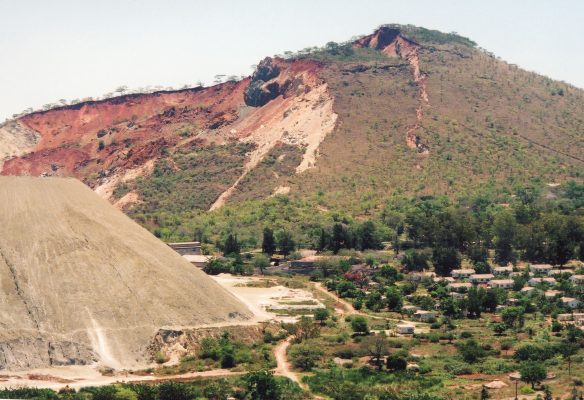As much as US$16 million was allegedly looted from SMM Holdings after administrator Afaras Gwarazimba lost control of the company to the State-owned mining entity, Zimbabwe Mining Development Corporation about 10 years ago.
SMM, formerly owned by businessman Mutumwa Mawere was placed under reconstruction in terms of Presidential Powers (Temporary Measures) (Reconstruction of State-Indebted Insolvent Companies Act) on September 16, 2004.
Government, through ZMDC took over the management of SMM in 2011 and reportedly injected US$16 million which, Gwaradzimba intimated in a recent meeting with employees, was stolen because he had lost control of the company.
The latest revelations are in an application by SMM workers through the Zimbabwe Diamond and Allied Minerals Workers Union to the Minister of Legal, Justice and Parliamentary Affairs Ziyambi Ziyambi seeking removal of Gwaradzimba.
Employees of SMM, the parent company of Shabanie and Gaths mines claim Gwaradzimba continued stay in office is illegal. In terms of the Act, Ziyambi is empowered to vary the reconstruction order by removing Gwaradzimba and any other person appointed to assist him. But this will need the High Court confirmation.
The workers claim Gwaradzimba, in a meeting held on March 8 this year intimated his continued stay in office was illegal as he was, at some stage, relieved of his administrative duties after the management of the company was transferred from Ministry of Justice to ZMDC under Mines and Mining Development Ministry.
He was to be re-appointed informally by a Cabinet Committee handling the SMM portfolio.
Gwaradzimba and SMM are being cited as first and second respondents respectively.
According to the application, Gwaradzimba was relegated to only deal with litigation brought against SMM by Mawere.
“The 1st respondent stated in our meeting that the ZMDC board had a US$16 million capital injection from the Government but it was squandered because he had no control over the company or funds,” read part of the application, now before Minister Ziyambi Ziyambi.
When he was “informally” reinstated, Gwaradzimba is said to have indicated that despite the capital injection, the company found itself in financial challenges, “having wasted investment capital on purchases of motor vehicles” and salaries.
Gwaradzimba also alleged late former president Robert Mugabe rejected the investor he had secured and directed the company removed from the Minister of Justice, then under Patrick Chinamasa to Ministry of Mines under Obert Mpofu.
Nearly 1000 ex-employees are owed US$17,6 million. The company is also said to have outstanding obligations amounting to about US$3,4 million to the Mining Industry and Pension Funds and US$2,7 million to National Social Security Authority.
Asset stripping
The workers have also alleged Gwaradzimba was converting SMM mining leases into residential stands. It is further alleged that he has already raised US$50 million through a deal struck with a local bank involving disposal of land under mining leases.
“He divulged that he is converting mining leases belonging to second respondent into residential stands….he claims he wants to (use the funds) to service what is owed to employees.
“These actions amounts to asset stripping. The obvious and natural consequences is that this undermines the viability of second respondent as a going concern.
“Effectively, first respondent has abandoned his primary duty of securing investors to resuscitate second respondent and then service the company’s debts.
Waning revival prospects
While the revival of Shabanie and Gaths mines remain a priority, some experts believe resuscitating the two mines might not make economic sense given high levels of structural weaknesses, huge capital outlay needed and low global demand of the fibre.
Instead, Government might need to concentrate on the dumps for the local market as challenges on the ground are clear that reviving the mines might not be feasible.
Some investors have been previously linked to the resuscitation of the mines over the past few years, but there hasn’t been much achieved in the regard. According to SMM, about US$120 million is needed to revive the two mines. Mining experts say that after the mines ceased operations, there was no proper care and maintenance, resulting in both mines flooding, thus submerging equipment.
The experts also said the mines have suffered fatal geotechnical failures such as roof collapses which makes it difficult “if not impossible” to access critical mining levels.
Similarly flooding may cause rock strata stability challenges, which calls for huge capital to reopen the mines.
The top three levels of Gaths mines are said to have collapsed due to flooding of the mines.
Compounding challenges related to the re-opening of the mines is that potential investors may not be keen to go into asbestos on the back of the lobby to ban the mineral.
Health authorities around the world have long advocated against the use of asbestos, saying it posed health risks when the silky fibres that make up the mineral get into the air that people breathe. When inhaled in significant quantities, asbestos fibres can cause a scarring of the lungs that impedes breathing; mesothelioma, a rare cancer of the lining of the chest or abdominal cavity; and lung cancer.
Asbestos, which is widely used in the construction and other industries has been banned in many developed countries, including the European Union. In some countries, such as Canada its use is strictly controlled through the laws, according to reports.
Business Weekly
.png)




